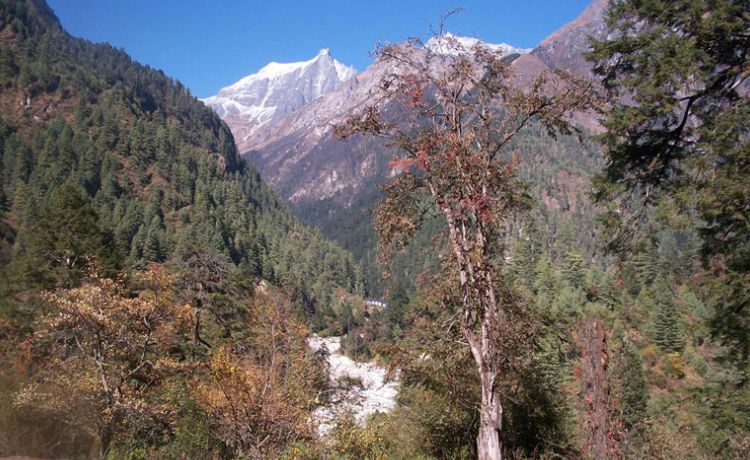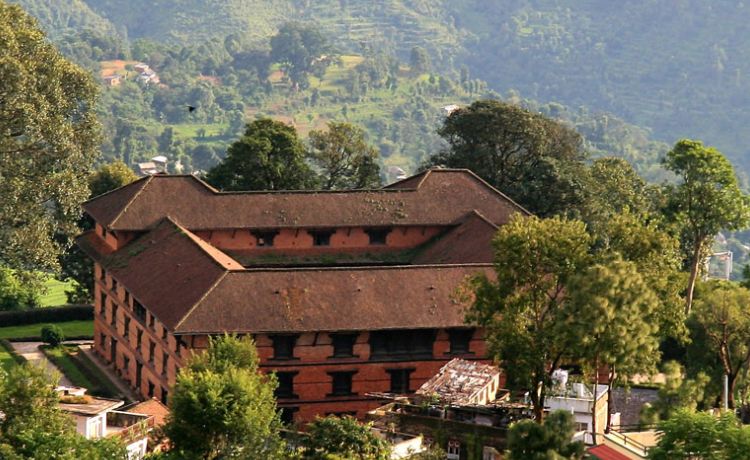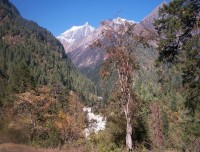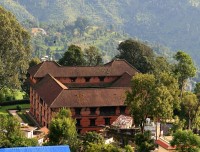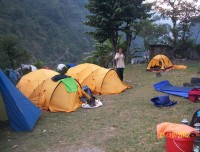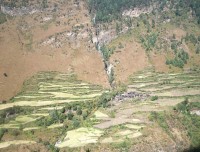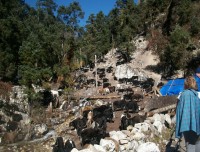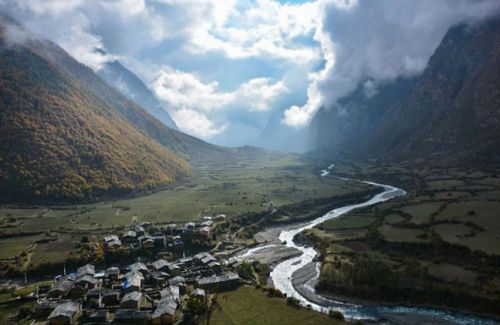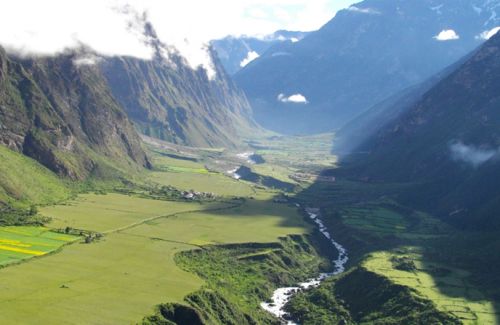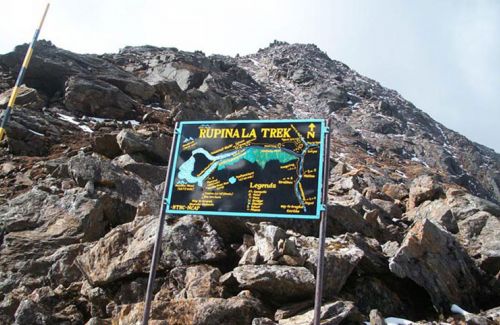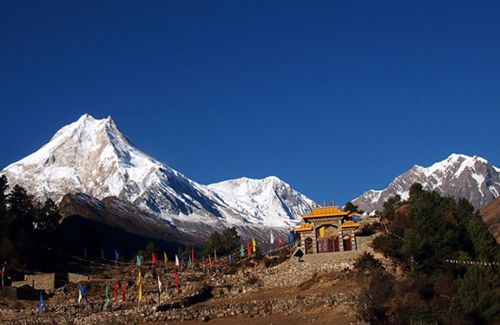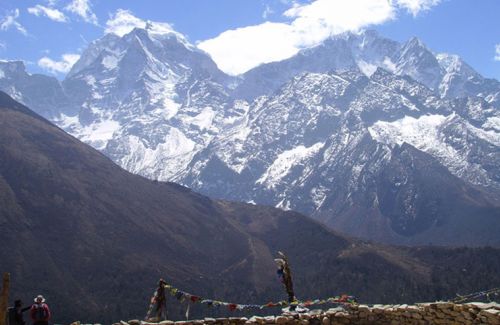Lower Manaslu Trekking
- Duration13 Days
- Max. Altitude2,700 m
- Starts FromUSD 980
Destination:Nepal
Trip Grade:Moderate (**)
Meals:Breakfast + Lunch + Dinner
Transportation:Public Vehicle
Trekking Region:Manaslu Region
Trekking Route:Kathmandu - Kurintar - Manakamana - Ghairung - Gorkha Bazaar - Bhachhek - Sirandanda - Barpak - Laprak - Nambai Kharka - Dharche - Tallo Thotneri - Ghyampesal - Kathmandu
Show AllLower Manaslu Trekking is recently explored touristic destination in the Lower Manaslu Region of Gorkha District. The nine days trek Lower Manaslu starts from Manakamana Temple, a powerful wish fulfilling Goddess worshiped with great devotion by Hindu devotees and concluded at Gorkha Bazaar via Ghairung, Namjung and Bungkot villages which have brought historical identity for example Lakhan Thapa , the first martyr of Nepal in Bungkot. Gorkha , the ancient capital of Nepal, is the place from where unification of Nepal was started by the king Prithivi Narayan Shah. There are number of places historically and archaeologically important. This is the place full of grandeur natural gifts and the land marked by plethora of historic, religious, ecological and cultural importance. This is the least tourists visited area but it has more tourism potentialities.
Besides the Manaslu Circuit Trek, Lower Manaslu trek offers experience of Moderate trekking, Historical tour, Pilgrimage tour, Agro tourism and Community Based Home – Stay. The first day of the trek begins from Kathmandu, three hours drive to Manakamana Cable Car Station at Kurintar of Chitwan along the Prithivi Highway. After 8 minutes , we reach to Manakamana temple then we proceed towards Bakyashwori Mahadeva temple (1515 m), 2 km north from Manakamana temple. It is believed that Goddess Sati’s tongue fell at Bakyashwori and speechless child could gain speech after offering prayers to the shrine. there is a sacred cave of Siddha Lakhan Thapa, founder of the Manakamana temple. The site offers enchanting views of Manaslu and other Himalayan ranges. We descend to Tinmane Bhanjyang then to Ghairung where there is a famous temple named Himalaya Devi and thousands of devotees gather there for special worshiping every year. The trail passes through the little hill where one can savor the natural vistas blended together with mountain massifs, Budhi Gandaki river and the adjacent hills one after another with little hamlets twinkling reflecting light from the tin roofs.
This is how we reach to Bungkot and Gorkha Bazaar where there are many places to visit especially the Gorkha Museum, Kalika temple, the cave of Guru Gorakhnath, the great sage. The next day we drive to Bhachhek then to Sirandanda through curvaceous mountain roads overlooking Daraundi river. Sirandanda is a hyolmo village and is situated at the hill top. The prime attraction of Sirandanda is Nagepokhari, Dudhpokhari,Bhoteodar, Chima and the tea garden. This village is rich for medicinal herbs. The other day we go to Ghyachowk via Mathar village, then after the lunch we proceed to Barpak Village, also known as the village of late captain Gaje Ghale, mostly inhabited by ex-army men. This village is being facilitated by the community for electricity, internet, medical and hotels. The unique sloppy shape with clustered stone tile-roofed houses, stone built narrow alleys and panoramic view of Buddha Himal are the major attractions of Barpak. From Barpak, we head to Laprak via Basukang. Basukang is the junction that also leads to Rupinala Pass – famous destination among Manaslu trekkers. Laprak is a typical Gurung village.
The wooden roofed houses which bears a uniform look in the entire village is one of its main attraction. after Laprak, we go to Nambai Kharka after 4 hours walk from Laprak. There is no animal killing in Nambai Kharaka because people believe that slaughtering of animals will bring illness to the trekkers, so one should be the vegetarian there. After this we hike to Dharche Danda(3,220 m) early the next morning which is the highest point of the Lower Manaslu trekking route. Some of the peaks that can be viewed from Dharche Dandaare AnnapurnaI, II, Bharatshikhar, Gangapurna, Machhapuchhre, Langtang, himalchuli, Buddha Himal, Sarang Peak, Malkunti Peak,Babu Himal, Sringi Himal, Ganesh I,II,III and others. Among Gurung community, Dharche Danda holds a religious significance. They offer prayer to the hill deity to avoid natural calamities. It is also believed that if tourists offer prayer to the hill deity, they will be blessed with clear visibility and will ward off misfortune while on trek. The day’s trek ends to Tallo Thotnery, a village enriched with Gurung culture.
The other day of the trek is descending down to the Sita cave (1165 m) which is 1.8 km far from Tallo Thotnery, is surrounded by the dense forest and holds a religious importance among Hindus. After a tour of the cave, the day ends with a trek to Ghyampesal, the final destination of the day, a few hours walk from Sita Cave. The final day is 2 and half an hours drive from Ghyampesal to Gorkha Bazaar and 6 hours drive back to Kathmandu.
Mount Manaslu is one of the eight highest mountain in the world and lies in the northern part of Gorkha and Lamjung districts. Manaslu was first climbed by the Japanese mountaineer Toshio Imanishi and Gyalzen Norbu on may 9, 1956. There are many different routs for the Manaslu region but the newly explored route from Manakamana to and the ending point to Ghyampesal is expected to be the popular to excavate vivid ethnic cultural realities through many villages in the days to come.
You can book Lower Manslu Trekking with Himkala Adventure for your enchanting Himalayan journey with well trained, professional mountain guide. If your time is favorable, you could join the group as we have our fixed departure dates for this trip. You could customize your trip as per your interest, time frame and budget. You may like other similar trips in Manaslu Region like: Manaslu Circuit Trekking, Rupina La Pass Trekking, Happy Tsum valley Trekking, Tsum Valley Trekking, Please, contact us for further more information.
Trip Highlights
- Sightseeing at World Heritage Sites in Kathmandu
- Drive from Kathmandu to Kurintar by public bus
- Drive from Gorkha to Bachhek by local bus
- Experience Nepals first cable car from Kurintar to Monakamana Temple
- Famous Manakamana Temple, the wishful-filling goddess
- Visit the Siddha Lakhan Cave
- Visit Historical Gorkha palace, Gorakhnath cave and Gorakhkali temple
- Experience the rich Gurung culture and cultural show in Sirandanda
- Trekking in Lower Manaslu Region of low Himalayan belt of Nepal
- Majestic views of Annapurna, Manaslu, Ganesh Himal and more
- Fascinating flora and fauna of hilly region
- Interaction with local people and know about their culture
- Drive from Ghyampesal to Kathmandu
Day to Day Itinerary
Day 01:Arrival in Kathmandu (1,350 m) and Transfer to Hotel. Overnight at Hotel
Day 02:Sightseeing tour in Kathmandu Valley and Trek Preparation. O/N at Hotel
Day 03:Drive to Manakamana (1302 m), 3 hrs, & trek to Ghairung (1,090 m), 3 hrs. O/N at Home Stay
Day 04:Trek from Ghairung to Gorkha Bazaar(1170 m), 4-5 hrs, O/N at hotel
Day 05:Explore Gorkha Bazaar and Hike to Gorakhkali Temple. O/N at Hotel
Day 06:Drive from Gorkha to Bhachhek and trek to Sirandanda (1,900 m) 6-7 hrs, O/N at home stay
Day 07:Trek from Sirandanda to Barpak Village (1,920 m), 7 hrs, O/N at home stay
Day 08:Trek from Barpak to Laprak (2,100 m), 6 hrs, O/N at home stay
Day 09:Trek from Laprak to Nambai Kharka (2,700 m), 4 hrs, O/N at camp
Day 10:Hike to Dharche Danda and trek to Tallo Thotneri (1,560 m), 7 hrs, O/N at home stay
Day 11:Trek from Tallo Thotneri to Ghyampesal via Sita Cave, 6 hrs, O/N at home Stay
Day 12:Drive from Ghyampesal to Kathmandu, 8 hrs, O/N at hotel in Kathmandu
Day 13:Transfer to the International Airport
Cost Include
- Airport picks up & drop by private tourist
- 3 nights’ twin sharing 2-3 star hotels in Kathmandu with Breakfast
- Guided city tour in Kathmandu by private tourist vehicle
- Full board meals (Breakfast + Lunch + Dinner) during the trek
- Home Stay basis accommodation during the trek
- Professional license holder English speaking guide
- The required number of local staff and porters (2 Trekkers = 1 Porter)
- Food, accommodation, salary, insurance, equipment and medicine for all staff
- Manaslu Conservation Area permit and TIMS permit for Lower Manaslu trekking
- Down Jacket, Duffle bag and sleeping bag by Himkala Adventure if required
- Drive from Kathmandu to Kurintar by public bus
- Drive from Gorkha Bazaar to Bhachhek by local bus
- Ride on the cable car from Kurintar to Manakamana Temple
- Drive from Ghyampesal to Kathmandu by public bus
- Farewell dinner in traditional Nepali restaurant with cultural show
-
All our government taxes, vat & service charges
Cost Exclude
- Lunch and dinner in Kathmandu
- Entrance fee in all monuments during tour
- Emergency rescue and evacuation cost
- Your travel insurance.
- Nepal entry visa fee which is issued in Kathmandu Airport
- Your personal expenses like phone bills, hot shower, battery recharge, laundry bar bills etc
- Personal trekking equipment
- Tips for trekking, tour staff and driver (Tipping is expected)
-
Any others expenses which are not mentioned on ‘Cost Includes' section
Detail Itinerary
Day 01Arrival in Kathmandu (1,350 m) and Transfer to Hotel. Overnight at HotelUpon your arrival at Tribhuvan International Airport in Kathmandu, our representative from Himkala Adventure heartily greets you and transfers you to the hotel in Thamel, the touristic area. After check in hotel, you could take rest or stroll around Thamel and see the local markets. Overnight in Kathmandu
Day 02Sightseeing tour in Kathmandu Valley and Trek Preparation. O/N at Hotel After breakfast, we begin our day tour and leave the hotel around 9 am. We visit Swoyambhu Stupa, affectionately called it the monkey temple. This is the old stupa built in 6th century, situated in the conical shaped hill, 77 m high from the ground level. We walk around the stupa and visit 7 puras, monasteries, descend to the Kathmandu Durbar Square. This is the place where we can see the palace built in 18th century, a museum, courtyards and many Hindu temples. After the sightseeing of this area, we move towards Boudha Stupa which is about 8 km far from Kathmandu city center. This is the biggest stupa in the southern Asia, in typical Nepali architecture. There are many monasteries around. The fourth place for today is Pashupatinath – the Shiva Temple. There are number of temples with Shiva Lingams. The holy river Bagmati is flowing and the golden roofed temple is residing on the bank of this river. There are many platforms for the cremation. After this, we return back to hotel. We give you the briefing about the Lower Manaslu Trek that we begin from tomorrow. Overnight at Kathmandu
Day 03Drive to Manakamana (1302 m), 3 hrs, & trek to Ghairung (1,090 m), 3 hrs. O/N at Home Stay After breakfast, we drive from Kathmandu to Khairenitar which is 105 km from Kathmandu by the Prithivi Highway. It takes about 3 hours. Then, we descend to the cable car where the station is on the bank of the Trishuli River. This is the only one cable car joined from there to the famous Manakamana Temple. This is run by the private company built under Austrian company. It was completed and inaugurated in 1998, November 24 by the Prince Dipendra Bir Bikram Shah Dev. This has 31 boxes where there are 3 for freight carriers. It is 2.8 km in distance and takes 8.40 minutes. We can visit the temple, its premises and ascend gently towards Bakyashwori Mahadev Temple at an elevation of 1,515 m, 2 km far from the Manakamana temple. There is Sidhha Lakhan Thapa Cave, about 500 m further uphill and the Manaslu Himalayan ranges can be seen from here. From there, the trail descends to Tinmane Bhanjyang and gradually ascends to Pipalchap village at Ghairung V.D.C. where we can spend night. Overnight at home stay
Day 04Trek from Ghairung to Gorkha Bazaar(1170 m), 4-5 hrs, O/N at hotel Today, after breakfast, we begin our trek ascending through the ridge of the hill from where we can view the panoramic view of Namjung V.D.C and the Budhi Gandaki. Similarly, the scene of adjacent hills are fascinating, we reach to Kaule Bhangar of Bungkot V. D. C. It is the birth place of Lakhan Thapa, who is the first martyr of Nepal. He was hanged to death with his friend Jaising Chumi Magar on 1993 BS for opposing the tyrant Rana regime. After this, we step ahead to Gorkha Bazaar through graveled road. The rural areas and the mixture of ethnic groups living together gives us wonderful feeling of unity. We finally reach to Gorkha Bazaar and stay overnight in hotel
Day 05Explore Gorkha Bazaar and Hike to Gorakhkali Temple. O/N at Hotel There are many things to discover in Gorkha. Gorkha is the historical place where the Shah dynasty originated. So, we can see the Gorkha Palace, Gorkha Museum. We can hike to Gorakhkali Temple. Nowadays there is bus service up to the temple on the pitched road. The Gorkhnath cave is worth visiting place where Baba Gorkhnath meditated. We can view the gorgeous scene of Manaslu Himal from there in a clear day. After the tour around Gorkha , we return back to hotel. Overnight at Hotel
Day 06Drive from Gorkha to Bhachhek and trek to Sirandanda (1,900 m) 6-7 hrs, O/N at home stay After breakfast, we drive from Gorkha Bazaar to Bhachhek which is 6-7 hours drive following the Daraundi River. We hike about one hour from Bhachhek to Sirandanda, to our final destination for today. There is a Hyolmo village situated on the hill top. Nagpokhari, Dudhpokhari, Bhote Odar, Chima, Dharadi and tea Garden are the prime attractions of Sirandanda. It is the best location for the sunrise and sunset view. The village has great source of herbal Medicines. Overnight at home stay
Day 07Trek from Sirandanda to Barpak Village (1,920 m), 7 hrs, O/N at home stay Today, we begin our trek to Mathar village from Sirandanda. It is northeast and takes about one and half hours. We stop for lunch at Gyachowk. After the four and half hours walk from Gyachowk, we arrive at Barpak. Barpak is the scenic village inhabited by ex-armymen. This is the village of late Captain Gaje Ghale, who was honored by the Victoria Cross Medal. Gurung and Ghale people are dwelling here. This village offers the well organized home stay facility along with standard hotels. Overnight at Hotel or home stay
Day 08Trek from Barpak to Laprak (2,100 m), 6 hrs, O/N at home stay After breakfast, we head towards Laprak today. We arrive at Basukang, the junction that also leads to the Rupina La PassLaprak is a vulnerable landslide zone. The earthquake 2015 destroyed this area a lot. This is typically the Gurung settlement which is a pit stop for the Manaslu trekkers. Overnight at home stay
Day 09Trek from Laprak to Nambai Kharka (2,700 m), 4 hrs, O/N at camp After the continuous 4 hours walk from Laprak, we arrive at an open pastureland with few temporary houses of Laprakis people. People use this shelter while planting and harvesting potatoes. We have to be self sufficient for food and lodging for the overnight here. So, the camping can be the good option here. We should be vegetarian while staying here because local believe that the slaughtering of animals will bring ill to trekkers. Overnight at camp
Day 10Hike to Dharche Danda and trek to Tallo Thotneri (1,560 m), 7 hrs, O/N at home stay We wake up early in the morning and hike towards Dharche Danda. This is the nice view point for the sunrise over the Manaslu ranges. Dharche Danda has religious significance. They offer oray to the hill deity to avoid natural calamities. Dharche Danda is the major Gurung community settlement. After this we descend to Tallo Thotneri, the village enriched with Gurung culture. We can enjoy the Gurung dance and local delicacies. Overnight at home stay
Day 11Trek from Tallo Thotneri to Ghyampesal via Sita Cave, 6 hrs, O/N at home Stay After breakfast, we begin to trek to Gyampesal from Tallo Thotneri. After 2 km down from Tallo Thotneri, we arrive at famous Sita Cave. The cave is 1,165 m high from the sea level. This holds a religious significance among Hindus. The visit to Sita Cave is very adventurous. Pilgrims visit this cave on Ram Nawami day. After few hours walk from the Sita Cave, we arrive at Ghyampesal. Overnight at home stay
Day 12Drive from Ghyampesal to Kathmandu, 8 hrs, O/N at hotel in Kathmandu After breakfast, we drive from Ghyampesal to Gorkha Bazaar. The bus departs at 8 am daily which takes about 2 hours. Then again we drive back to Kathmandu from Gorkha, takes further 6 hours by bus. Himkala arranges the dinner together with typical Nepalese Cultural Show. Overnight at hotel in Kathmandu
Day 13Transfer to the International Airport We depart you to the International Airport 3 hours before to your scheduled flight. If you have enough time, you could go for shopping in the local market around Asan, Indrachowk, and the dainty gifts to your family members, relatives and friends. We finally depart you to the airport. We are very much obliged to you that you joined Himkala Adventure for the trek to Lower Manaslu Trekking. Hope to see you again and we wish you to have safe journey to your onward destination. Namaste!!!
Trip FAQ
Himkala Adventure would like to answer all the queries about Lower Manaslu Trekking for all curious travelers/trekkers in the world. As you are entirely from different geographical location, you could better to know everything about the treks from the beginning i.e. airport pick up till your departure like airport picks up, drops off, accommodation in city, in the trek, guide and porters, safety for the trekking, food and accommodation and some other things that you might face on the way. Hope our endeavor listing these questions answers will help you self informed.
This is simply the outlines of the services we offer but it may differ as per your requirement, number of trekkers. What we go through our conversation, we will manage the means of transportation, hotels in the city, accommodation in the trekking, numbers of porters etc. This is general idea about Lower Mansalu Trekking before your trip and you become clearer about the trek. Please feel free to contact us to get more information about the trekking in the Himalayas of Nepal.
1) How is Lower Manslu Trekking in Nepal?
Lower Manaslu trekking is newly explored trekking route in the lower belt of Manaslu Region at Gorkha district. The trail passes through the highly revered goddess temple Manakamana and the historical place Gorkha Durbar, Kalika Temple which was the origin of Shah Dynasty. This trail offer the majestic mountain view of Ganesh Himal and Manaslu ranges. The true picture of village life in the hilly can be experienced here.
2) Why Lower Manslu Trekking is the most popular trekking in Nepal?
The reasons Lower Manaslu Trekking is the most popular trekking in Nepal are given below:
- Drive from Kathmandu to Kurintar by public bus
- Drive from Gorkha to Bachhek by local bus
- Experience Nepals first cable car from Kurintar to Monakamana Temple
- Famous Manakamana Temple, the wishful-filling goddess
- Visit the Siddha Lakhan Cave
- Visit Historical Gorkha palace, Gorakhnath cave and Gorakhkali temple
- Experience the rich Gurung culture and cultural show in Sirandanda
- Trekking in Lower Manaslu Region of low Himalayan belt of Nepal
- Majestic views of Annapurna, Manaslu, Ganesh Himal and more
- Fascinating flora and fauna of hilly region
- Interaction with local people and know about their culture
- Drive from Ghyampesal to Kathmandu
3) What physical fitness do I need to book this trip?
Every trekking in the Himalayas of Nepal requires the certain level of physical and mental fitness. So, we advise you to be in good physical shape and able to feel comfortable while hiking up and down 7 to 12 miles per day on a trail carrying a day pack of about 10 pounds. Three things could make you confident enough for any trek you would like to do: aerobic, strength and mental.
Aerobic conditioning is important primarily because you will be trekking in thinner air, up to 40% less than at sea level. With good aerobic conditioning, you will be able to better metabolize whatever oxygen is available to you. You should plan on doing at least one hour of aerobic 3 /4 times per week for 1 month or more before your arrival in Nepal. Walking, jogging, cycling, hiking on floor to ridge line ascents with day back are some of the excellent forms of exercise, so long as you are strengthening leg muscles and building stamina. Speed is not the essence; stamina, confidence and continuity are. Do as much uphill as possible. If you live in flat area, go to the stadium and use the steps with your pack.
4) Do I really need to use guide to Lower Manaslu Trekking?
You are advised to use Guide so that you could feel safer in the unknown area because the guide can tell you the possible danger as they have guided in this region since long. Most importantly, the Himalayan weather is really unpredictable and the Guide can help you to take proper shelter. Nest advantage to be with Guide is you get more knowledge about local culture and you could have easy access to interact with the local people. In 2014, the Nepal Government clearly has stated that the trekkers should have a guide but still it is not seemed in the practicality.
5) How do I find Himkala Adventure for my pick up at the airport?
Our representative from Himkala Adventure will display a small board (placard) of company or your name outside the airport terminal. You will be driven to the hotel by our tourist vehicle.
6) What sort of accommodation do I get in Kathmandu?
Normally we provide standard rooms with twin sharing accommodations at three star or similar category hotels in Kathmandu including breakfast. Accommodation in these cities can be upgraded as per your request. But some of our packages are sold without accommodation in the city.
7) How are tea house facilities during Lower Manaslu Trekking?
Tea House is the combination of guest house, restaurant, and social hang out. Tea houses in Lower Manaslu Trekking area are professional though they are simple but with neat and clean lodging offering fine views and plain but fresh and hygienic food with friendly atmosphere Most of the Tea Houses have running water facility. Many of them have hot water available for bathing. But we discourage our groups from using water heated by wood as lack of firewood in most villages is a big environmental concern in Nepal.
8) What sort of accommodation do I get in trekking?
Guesthouses/Tea Houses/Lodges provide twin sharing single and double rooms and occasionally a dormitory which is basically clean with a mattress and a quilt or blanket. Our company provides the sleeping bag if needed but we always recommend having your own sleeping equipments. You have to share the room with your group member or sometimes with unknown traveler. The toilet is always outside the room with basic facilities.
9) What sort of foods, water and drinks can I expect in trekking?
The foods in the Himalayas are very simple. There are mostly the family members themselves to cook and serve the meal. They are simply trained but experienced because they have been offering such services for many years in this busy route. The food is hygienic, fresh and delicious. We recommend you to drink mineral water or the boiled or using water purification pills or drops.
Most of the foods are cooked in the kitchen of tea houses. They serve you with different varieties of delicious Nepali and continental dishes. The most popular Nepali food is daal bhat (rice and lentils) with some mixed vegetable curry. Garlic soup is popular as it helps you with acclimatization. You could better be vegetarian in the mountains. All hotels in cities and guesthouses in trekking serve the vegetarian food. You can find all common types of drinks like hot chocolates, coffee, tea, hot lemon with honey, ginger tea, soft drinks etc. you will have your breakfast and dinner at the lodges where you will be staying and lunch somewhere on the way to your next destination.
10) What mode of transportation do I use?
We will provide the private transportation for Airport/Hotel/Airport pick up and drop and sightseeing in Kathmandu Valley. We use transportation as based on our cost inclusion section. The transportation varies depending on your requirements at the time of booking the trip.
11) What is the best season for this trekking?
The best season for Lower Manaslu Trekking is spring (March to May) and autumn (September to December). These are the perfect time of the year for the breathtaking views of Himalayas with clear and sunny days. But the weather in the mountains is unpredictable.
12) What is the weather and temperature like during the trekking?
The climate in Nepal varies from place to place which can be categorized in different four main seasons. The main seasons in Nepal are spring (March to May), summer (June to August), autumn (September to November) & winter (December to February). The best season to travel in Nepal is autumn (September, October & November) & spring (March, April & May). Weather in the mountains is unpredictable. But the day temperature in Lower Manaslu Trekking is comfortable.
13) Who will be guiding me during this trip?
We provide the professional government license holder English speaking trekking guides for our entire trekking trip. We can also provide French, Spanish, Japanese, German or Italian speaking guides as per your preference with extra payment but not guaranteed. All guides will be Nepali people who are carefully selected on the basis of their appropriate experience, leadership skills and personality. They are all trained from Nepal Academy of Tourism and Hotel Management, certified and approved by the Tourism Department of Nepal government. We provide a different city tour guide to guide you in UNESCO World Heritage Sites in Kathmandu. They are the professional license holder guide specialized in culture, history, geography, iconography, archeology and religion with good command over English. Tour guides are specialized in city tour and trekking guides are more in the hiking and trekking in the Himalayas.
14) What sort of experience do your guides have?
Our entire city tour guides have bachelors to Master Degree academic education along with many months tour guiding training from Nepal Academy of Tourism and Hotel Management, Rabi Bhawan, Kathmandu, Nepal. They are fluent in spoken languages and informative about the sites in many aspects. They are quite experienced and dedicated to their job and responsibilities.
Our entire trekking guides have minimum Intermediate to Master Degree academic education with trekking guide training from Nepal Academy of Tourism and Hotel Management, Rabi Bhawan, Kathmandu, Nepal. Many of them are from villages. As they are local, they know more about the routes, necessary precaution to be taken and so on. They have spent many years exploring many parts of the country. They are trained in first aid and able to handle any situation easily. They speak good English and make you know about the places you visit.
15) May I charge my electronic gadgets during Lower Manaslu trekking?
Most of the places in your tea houses have charging facilities. You can charge your devices by paying some extra money. It’s good if you bring TWO or THREE pin travel adapter and put your gadgets at warm place at night.
16) How much additional money is required for this trip?
It’s a very personal question as expenses depend on habit. Normally, in Kathmandu you can allocate about USD 10 to 15 per person per lunch or dinner. USD 10 to USD 15 per person per day will be sufficient to buy bottles of water, chocolates, pay for a hot shower during the trekking. Other personal expenses will be your own calculation.
17) What is the social and environmental responsibility of Himkala Adventure for this trip?
The situation of environment in Nepal is in considerable stage due to so many factors caused by global warming, human activities, and adverse effects of natural incidents. Nepal is in between two giant countries like China and Nepal. The ozone layer is depleting and the atmosphere is getting heated. So, its direct effect is to the Himalayas that the snow is melting day by day and the sea level is rising. It is due to population growth, people are clearing the forest and the soil is being eroded. As a part of society, and our trekking related activities are directly concerned with the social and environmental things. We are very conscious not litter in the open spaces, to manage garbage properly and make local people aware in this campaign. We are working together with other companies and taking these issues seriously.
18) What is the minimum number requirement for this trip?
We operate individual trip to the group joining trips for Lower Manaslu Trekking. If you want to do any private trip we are ready to organize for solo traveler as well with some additional charges.
19) Are there communication or internet services during Lower Manaslu Trekking?
All our guides carry the local mobile phone. You can use his mobile phone to make any local or international call from trekking trails by paying him directly. You can even pass him number to be connected with your family or friends. We highly recommend taking local SIM card for call and internet services during trekking. Local SIM cards are easily available in many stores and at airport as well. You need to provide two copies of your photographs and your passport copy to get local SIM CARDS of NCELL & NTC (only these two companies provide telephone services in Nepal.
20) May I get chances for shower during Lower Manaslu Trekking?
Most of the guesthouse provides hot shower with some extra cost. In few places, bucket water will be provided for the shower.
21) May I add extra days in trekking?
Yes. You can customize the trek as you would want. We are flexible while preparing the itinerary and you could lengthen or shorten it as per your requirement.
22) What happens in case of emergency?
Himkala Adventure has prepared for any emergency situation and knows how to handle it. Our guides are trained in first aid and can deal with most of the basic ailments that occur during the trek. Every client should have his own insurance before coming to Nepal for the case of emergency.
23) Do I need to have insurance for this trip?
We request you to have a travel-insurance policy to cover theft, loss, medical problem & emergency helicopter evacuation from high altitude places before coming Nepal. Choose a policy to cover your emergency high altitude helicopter evacuation with all medical insurances for trekking in high altitude in the Himalayas of Nepal. Your travel insurance is always needed before going in any high altitude trekking. Please check your travel insurance policy which doesn’t exclude mountaineering or alpinism. Although you will not be engaging in these activities in your trekking, you might have problem convincing the insurance company of this fact. Rescue insurance need to cover an emergency helicopter evacuation or a charted flight from remote mountain trails of Nepal as well as international medical evacuation. A helicopter evacuation might cost US$ 2500 to US$10000 depending on the places. So that travel insurance to cover all above is must to travel in the high Himalayas of Nepal.
24) What type of shoes should I wear during Lower Manaslu Trekking?
You could better have carefully chosen sneakers/hiking boots with extra laces which should be kind of strong, well-made but light boots for Lower Manaslu Trekking. Shoes and boots are best to buy before arriving in Nepal. We advise you to wear your new shoes for sometime before trek so that you could feel well habituated on the newer trail for your feet.
25) Can I use credit cards in the Lower Manaslu Trekking route?
No, you can use only in the cities like Kathmandu. So, it is better you to make change in Kathmandu. When you are out of city, all you need is cash, better to have small notes. Please change the currency in local Nepali rupees before you go to the mountains.
26) Do I need to tip my guide and porter? How much would that be?
Tipping is not mandatory, neither it is right to ask by anyone but it is a way of showing gratitude after taking service. The level of tip also shows how satisfy you are from the team that you had been during your tour/trek.
However, we recommend you to spend minimum 10% of your total trip cost for tipping entire local staffs, the ratio of tipping guide and porter will be given to you at the pre-trip meeting in Kathmandu before starting the trek.
27) How is Camping Trek to Lower Manaslu being operated?
Camping trek is fully organized and supported, with a team of guides, cooks, and porters to accompany you. Our porters carry all the trekking gear, food, fuel and personal belongings. Our cooks prepare hot meals. Trekkers need only carry a small bag as required for the day. At night, tents for dining, sleeping and ablutions tents are provided and set up, also mattresses and down-filled sleeping bags, tables and seating.
In a typical camping trek, we start the day around 6 a.m. with a cup of hot tea. You are then provided with a bowl of warm water for washing. Then trekkers enjoy breakfast before leaving camp. The trek begins around 7.30 - 8 a.m.
Trekkers can set their pace for pausing and sightseeing and the walk to the lunch spot will normally take 3 hours. On arrival, you are served hot lunch. In the afternoon, after walking for another 3 to 4 hours, you arrive at the next camp around 5 p.m. Tea & snacks are served while our staff readies the camp. Dinner time is around 6/7 p.m. in the dining tent, lit with lanterns and comfortably furnished. The food is healthy, wholesome and hygienically prepared.
Trip Note
Cost:
The cost of trip varies according to the number of travelers in the group, the category of the Hotel, mode of the transportation and any kind of changes (if there is). So, if you would let us know all of these above mentioned things, then we could quote you the exact price.
Essential Documents:
You are requested to send the following documents after you confirm or book the trip with Himkala Adventure:
A copy of your passport and travel/health insurance documents with contact details, three passport size photos.
It is advised to maintain a separate photocopy of all important documents including traveler’s cheques, bank/ATM card, contact numbers, international flight tickets, and emergency contact numbers.
Weather:
The main trekking season in Nepal is from October to December and March to May. The day temperature for walking to Lower Manaslu Trekking is comfortable. As this trekking goes from the lower belt og Manaslu region, the weather is always pleasanr, mild and soothing. There is occassionally rainfall.
Nepal Strikes:
There is much more progress in the political scenario in Nepal and we assure you that travelling in Nepal is safe. But there may be Bandha (wide transport strikes) at a very short notice. The shuttle bus is in operation by Nepal Tourism Board and the Nepal Tourist Police in conjunction with the Himalayan Rescue Association from domestic and international terminal to the various hotels in Kathmandu. The service costs 300 rupees per person.
Itinerary Disclaimer:
Himkala has thoughtfully designed all the itineraries but our itineraries are updated for the betterment on the basis of our past travelers’ comments and our own research. In case you find changes in the itinerary you printed and the upgraded one does not affect your trip. Please note that some changes may occur in our itineraries due to bad weather and common seasonal changes to timetables and transport routes.
Physical Rating:
Your trip will be meaningful if you could find yourself fit and fine. You will be walking up to 2,700 m from the sea level. As the geographical region varies, there is a temperature variation as well. So, we advise you to undertake regular physical exercise, jogging, hiking, riding, ascending and descending the long stairs etc.
Group Size:
Himkala Adventure organizes solo to group travelers. Our group trips are designed for sharing accommodation and there is no single supplement. Single travelers share with the same gender from twin to multi-share in an accommodation. You are requested to have mutual understanding in between the fellow travelers who have joined from the different parts of the world. Please remember that you have great responsibilities in the group. If you are requested to be at a particular place at a certain time, make sure that you have been there at a time. It is much more pleasing sharing experiences and traveling together.
Accommodation and Meals:
Accommodation and Foods in the Himalayan region of Nepal cannot be compared with any developed countries in the world. We know that you might not have experienced such things before but you should take it easy. Accommodations at local lodges are simple but clean and comfortable. The food is plain. Toilets and washing facilities are shared and rudimentary. In high altitude regions, there are very few tea houses and one has to be happy to share in simple dormitories without electricity, without running water. Hot shower means a bucket of hot water upon our request.
Money Matters:
Please note that most establishments in Asia will not accept foreign currency notes that are old, torn or faded and they can be very difficult to exchange or extra fees added when exchanging at banks. Please ensure that you have new, clean notes.
The official currency of Nepal is the Nepali Rupee (NPR). ATMs can be found only in major cities of Nepal like Kathmandu, Pokhara, Chitwan, Bhaktapur etc. The government of Nepal has banned the import, export and use of 500 and 1000 Indian rupee notes in Nepal. You make sure that you won’t carry these notes upon arrival in Nepal, otherwise they are confiscated and you may be fined.
Please make sure that the foreign currency notes that you have are new and clean notes because old, torn or faded foreign currency notes in Nepal are very difficult to exchange or extra fees added when exchanging at banks.
While travelers cheques have security advantages exchanging them can be a lengthy process, commissions can be high (up to 10%) and they can be difficult to change in rural areas, on weekends and public holidays. If you choose to bring travelers’ cheques, make sure they are a major brand and major currency.
Tipping:
Tipping is not mandatory. It is not anyone’s right asking for tips but if you are happy with the service, you could tip the staffs. It is entirely a personal preference. Tipping could be significant to them who took take great care of you in your traveling period. Himkala recommends that you could tip any intended recipient by any member of the group than collected and passed on by the group leader.
Note: Please do not tip with coins or dirty and ripped notes. This is culturally taken as an insult.
Local Dress in Nepal:
Nudity is a sensitive issue in Nepal. Women should avoid wearing shorts and sleeveless tops in public places where this might be seen as inappropriate. Remove shoes before entering certain holy places. Non-Hindus are not permitted in some temples.
Feedback:
Your feedback will be the great guidance to meet our target and to bring improvement in our service. What and how have you experienced with Himkala Adventure and our staff? Please write, we will read it carefully. One cannot see his/her shortcomings that are lying with them. Someone should point it out. We are always eager to hear from you.
Trip Info
- Communications and Updates
- Conservation
- Cross Cultural Issues
- Essential Do’s and Don’ts
- Foot Ware/Foot Care
- Health and Fitness
- Himkala Crews
- Safety and Security
- Travel Insurance and Evacuation
- Trip FAQs
- Washing and Shower
- Water/Food and Nutrition
- Weather
- Trip Grading
- Accommodation/Shelter
- Altitude Sickness
- Equipment List
